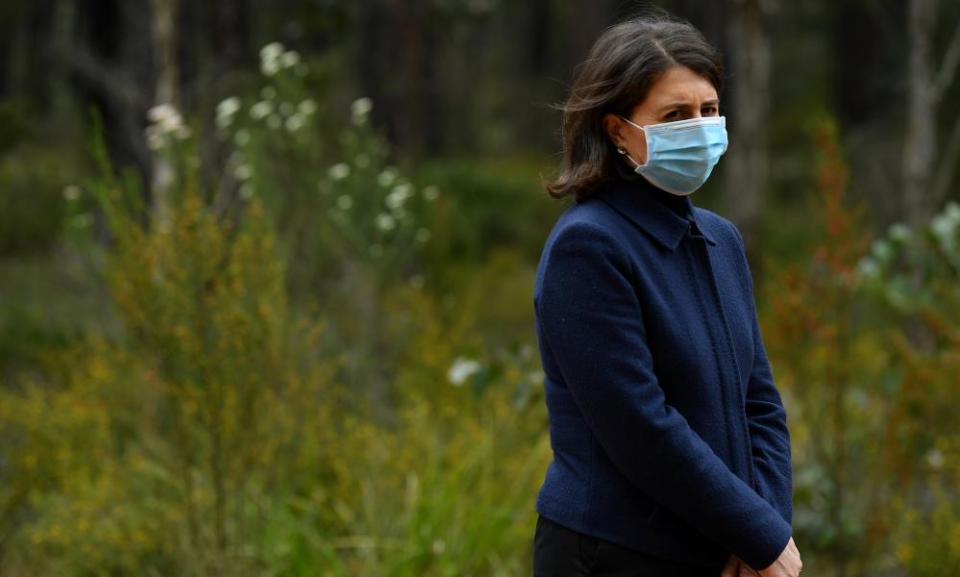Part of new national park planned for western Sydney set aside for highway

A portion of bushland at the site of a new western Sydney national park where koalas, bettongs and other native animals will be released is to be set aside for a future highway.
The Berejikilan government announced on the weekend that the bushland at Shanes Park in the Blacktown city council area would become one of the largest national parks in western Sydney.
The proposal includes a “rewilding” project that will involve up to 30 native species being released into the area, which will be fenced to exclude predators.
Related: Australian bird of the year 2021: vote now for your favourite #birdoftheyear
The NSW environment minister, Matt Kean, said the new park would become a tourist destination that would allow visitors to experience what western Sydney’s bushland was like more than 200 years ago.
But under the government’s plan, 20 hectares of the site will be reserved for a long-planned road corridor that would connect Sydney’s M7 motorway to the western slopes.
Conservationists from the area who have campaigned for the protection of the entirety of the Shanes Park site for almost two decades told Guardian Australia they had hoped it would all be protected.
“I’m disappointed because the whole site has conservation value and was originally intended to be preserved for that conservation value,” the flora and fauna manager for the Blacktown and district environment group, Wayne Olling, said. “There’s a sleight of hand here and it’s disappointing we can’t trust the government on environmental issues.”
The new park will be located on land previously owned by Airservices Australia and the site of a former radio transmitting station.
At 558 hectares, the parcel of bushland is one of the largest remnants of vegetation that used to cover western Sydney, and has been identified by both state and federal governments as a conservation priority for decades.
In 2011, under an agreement between the state and federal governments, the establishment of a reserve at the site was selected as one of the main offsets to compensate for the construction of 181,000 houses in new suburban developments.
Guardian Australia revealed in February that 10 years on the reserve still had not been established because of a dispute between the two governments about the road corridor.
The land was transferred into state government ownership late last year, with the new national park announced by the Berejiklian government on Sunday.
Related: Zero extinction target for NSW national parks welcomed by environment groups
The rewilding project will see the reintroduction of up to 30 species, including 12 priority animals – the green and golden bell frog, the koala, the emu, the eastern quoll, the eastern bettong and the brown antechinus among them.
Under the plan, 555 hectares of the site will be enclosed by a feral-proof fence.
But the government only intends to formally protect 535 hectares as national park – through a process known as gazetting.
An area of up to 20 hectares will remain unprotected to allow for its potential use for the road corridor and a smaller area of five hectares will also be excluded as it is the site of a pistol club.
The NSW department of planning and environment said construction of the road was unlikely to occur for at least 15 years. If it proceeds, the government will be required to offset the damage to its own offset.
Lisa Harrold, the president of the Mulgoa Valley Landcare Group, has been a long-term campaigner for a rewilding project at Shanes Park.
In the 2007 federal election, she ran as an independent on a platform to protect both the Shanes Park site and nearby bushland at Orchard Hills.
Harrold attended Sunday’s announcement and said she was disappointed to later learn the section of bushland intended for the road reserve would not be part of the national park.
“The fight never ends. You think you have a win but do you ever really have a win?” she said.
But she said protection for the remaining 535 hectares had been a long time coming.
“For us, it’s not just about adding back the animals and fauna of the Cumberland plain. It’s about managing a very valuable bushland remnant which is surrounded by urban development.”
Kean said the project was one of the biggest urban wildlife restoration projects in Australian history and would be like “stepping back in time to see the Australian bush alive with native animals as it was before foxes, cats and rabbits had such a devastating impact”.
The minister for tourism and western Sydney, Stuart Ayres, said it would become a “must-see destination” for local and international visitors.
Conservation organisations greeted the announcement with mixed feelings.
Gary Dunnett, the executive officer of the National Parks Association of NSW, said it was a relief the site had finally been announced as a reserve and that the addition of local fauna could assist with the restoration process.
Related: Cockatoos in Sydney learning from each other to bin-dive for food, study finds
But he was disappointed the park had ultimately come at the expense of bushland elsewhere when the need to protect the site was identified long before it was chosen as an offset.
“We shouldn’t accept that we only end up with new parks because somewhere else is destroyed,” he said.
Chris Gambian, the chief executive of the Nature Conservation Council of NSW, agreed.
“Let’s be clear, the protection of this island of habitat has come at the expense of biodiversity right across the western Sydney growth suburbs,” he said. “The new national park doesn’t even cover the full area that was set aside.”
Gambian was also concerned the site was not large enough to support a genetically independent koala population without ongoing human intervention and management.
“Whilst we are supportive of any efforts to conserve threatened species, this park will be more like a zoo than a natural ecosystem,” he said.

 Yahoo Finance
Yahoo Finance 